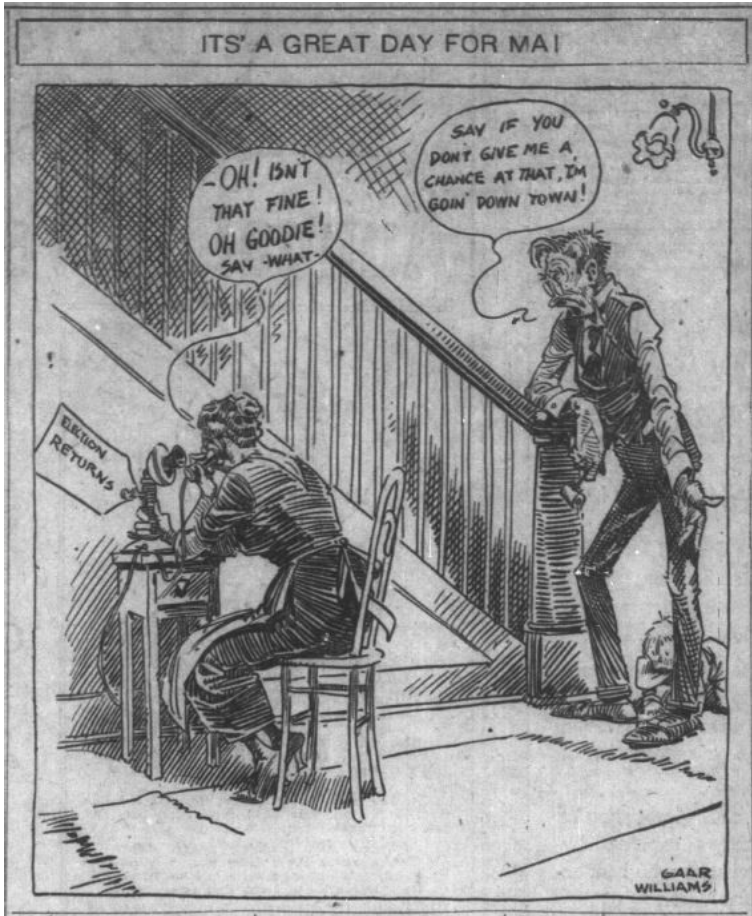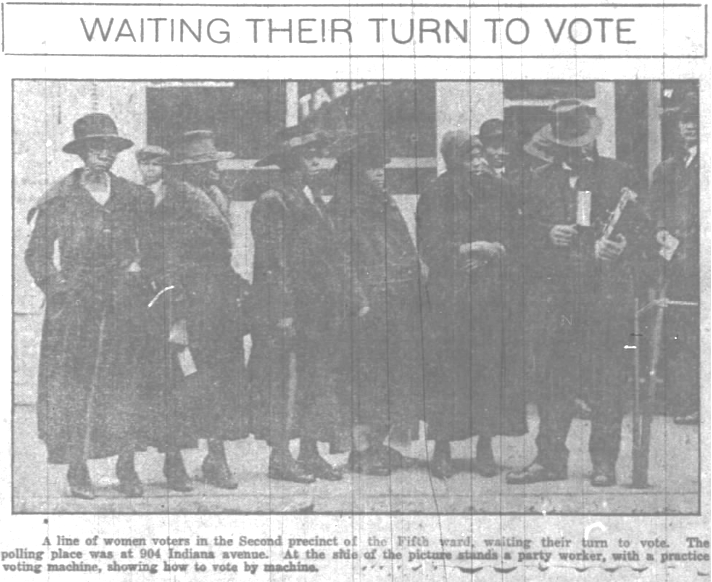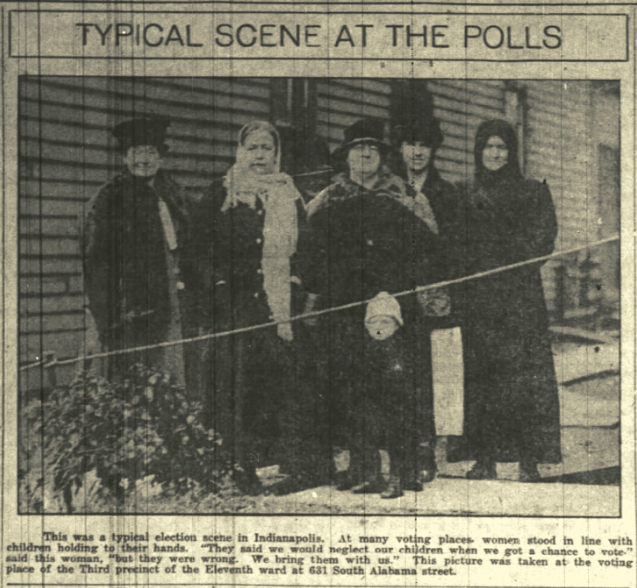In our October newsletter, we encouraged readers to dig into Hoosier State Chronicles to discover stories from November 2, 1920, the first time Indiana women voted. Heeding the call, I reviewed one newspaper to learn more about how women voted and how they were perceived on that historic day.
The front page of the evening edition of The Indianapolis News on Tuesday, November 2, 1920, featured this political cartoon, depicting a woman with the phone held close, anxiously awaiting the election returns while her husband griped off to the side, with a child at his feet.

The article that followed the cartoon took up a column on the front page and continued across multiple columns inside the paper. Titled “Riot of Colors in Voting Lines,” the article’s bylines read “Mrs. Voter Shows Mr. Voter Some Styles He Never Dreamed of Seeing at Polls / Charming is the effect: The Adjective May Be Used Unsparingly to Describe This, That and the Other.”
It continued,
“Scarlet, green, blue, brown, pink and other such well known shades as Zanzibar, dryad, rust, cinnamon, Suchow, taupe, pine needle green, chefoo, navy and twilight, colored the voting lines in Indianapolis today with a gay touch new to the eyes of voters of past years, when Mrs. Voter went to the polls to cast her first vote. The beneficial influence of the women at the polls was certainly noticeable from an aesthetic standpoint. At nearly every voting place was a woman pollbook holder, charmingly dressed and charmingly mannered, even to women of the opposing party. Brilliantly dyed shawls were much in evidence.”
While it seems trivial to mark such a significant day in the history of women’s rights by calling out their clothing, it was the distinct appearance of women at the polls that made for an unavoidable reminder of the momentous change that had occurred. (Also, men’s clothing sounds like it was pretty boring by comparison!)
The article continues:
“The number of women at the polls gave the lie to the old anti-argument that women did not care enough about voting to go to the polls. On the contrary, election officials said, the woman vote would be found to be proportionate to the number of men voting. Throughout the day, at all the voting places, many women were constantly in line, in the piercing cold wind, waiting their turn to vote.”

Most interesting to me, however, were the accounts gathered from across Indiana, each offering a short blurb on that day’s voting affairs. Most offered a quick comment on the weather, any unique information, and more often than not, a comment about the presence of women at the polls. Here are a few of these county-level reports, with some of the thoughts they raised for me:
Cass: In Logansports, “Many women went to the polls early, one woman with a lantern in her hand was waiting for the polls to open in the first precinct of the third ward here.” [Don’t you just wish someone had captured this moment on camera? I’d love to see this woman, so eager to vote for the first time that she came prepared with a lantern to wait out the dark and cold!
Hancock: In Greenfield, “the first ballots at each of the eleven precincts in this city were cast by women”
Elkhart: Goshen reported, “The woman vote was heavy. Mrs. Adeline Gray, of Elkhart, age ninety-four, and Mrs. Adeline Smith, of Goshen, age ninety, were among the early voters.” [I would have loved to have seen these women at the polls, knowing they had had been alive for the entire duration of the fight for women’s suffrage in Indiana, which first kicked off in 1851 in Wayne County!]
Henry: Newcastle reported, “The women experienced no difficulty in voting on machines.” [While sexism and gender-based discrimination are still issues faced today, it baffles me that there was genuine concern over women being incapable of using the voting machines.]
Vigo: In Terre Haute, “It was said that up to shortly after noon about three women had voted to each man.”
Knox: Vincennes reported “At practically every voting place women were waiting to vote when the polls opened at 6 o’clock…unusual activity was displayed among the workers, including a number of women who are driving automobiles and hauling voters to the polls.”
While COVID make it unsafe to haul voters to the polls, don’t forget that your voice matters—and don’t forget to remind your friends to exercise their vote too!

This post was written by Lydia Prebish, the Public History Intern at Indiana Humanities and a graduate student at IUPUI’s public history program.


